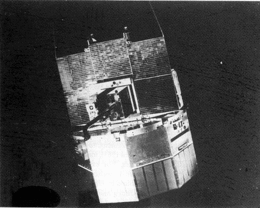OSO 7

The OSO 7 satellite, like the other Orbiting Solar Observatory missions, was primarily a solar observatory designed to point a battery of UV and X-ray telescopes at the Sun from a stabilized "sail" pointing platform mounted on a rotating cylindrical "wheel".
|
|
| Operator | NASA |
|---|---|
| COSPAR ID | 1971-083A |
| Mission duration | 3 years |
| Spacecraft properties | |
| Manufacturer | Ball Brothers Research Corporation (BBRC) |
| Launch mass | 635 kilograms (1,400 lb) |
| Start of mission | |
| Launch date | September 29, 1971, 09:50:00 UTC |
| Rocket | Delta-N |
| Launch site | Cape Canaveral LC-17A |
| End of mission | |
| Decay date | July 9, 1974 |
| Orbital parameters | |
| Reference system | Geocentric |
| Eccentricity | 0.018376 |
| Perigee | 321.0 kilometers (199.5 mi) |
| Apogee | 572.0 kilometers (355.4 mi) |
| Inclination | 33.10 degrees |
| Period | 93.20 minutes |
| Mean motion | 15.45 |
OSO 7 or Orbiting Solar Observatory 7 (NSSDC ID: 1971-083A), before launch known as OSO H is the seventh in the series of American Orbiting Solar Observatory satellites launched by NASA between 1962 and 1975. OSO 7 was launched from Cape Canaveral on 29 September 1971 by a Delta N rocket into a 33.1° inclination, low-Earth (initially 321 by 572 km) orbit, and re-entered the Earth's atmosphere on 9 July 1974. It was built by the Ball Brothers Research Corporation (BBRC), now known as Ball Aerospace, in Boulder Colorado.
While the basic design of all the OSO satellites was similar, the OSO 7 was larger [total spacecraft mass was 635 kg (1397 lb)] than the OSO 1 through OSO 6, with a larger squared-off solar array in the non-rotating "Sail", and a deeper rotating section, the "Wheel".
The "Sail" portion of the spacecraft, which was stabilized to face the Sun in all the OSO series satellites, carried two instruments on OSO 7, which continuously viewed the Sun during orbit day. These were:
The rotating, "Wheel", component of the spacecraft, which provided overall gyroscopic stability to the satellite, carried four instruments which looked radially outwards, and scanned across the Sun every 2 sec. Two of these were solar observing instruments, and the other two were cosmic X-ray instruments:
Among the notable scientific results from OSO 7 were:
The OSO 7 was nearly lost at launch, due to a loss of hydraulic pressure in the second-stage guidance control system ~7 seconds prior to SECO. The nominal plan was for the spacecraft to be separated from the second stage with the spin axis normal to the Sun direction, so that the sail could be oriented to the Sun, allowing the batteries to be fully charged on orbit. As it was, the orbit was slightly eccentric instead of circular, and the orientation of the spacecraft immediately after launch was unknown, so that the sail could not acquire Sun lock. The spacecraft was launched with its batteries fully charged, giving approximately 12 hours for the controllers, directed by NASA's John Thole, to recover before the spacecraft lost power and command ability. Several hours passed as engineers attempted to interpret the signal strength from the tumbling spacecraft in terms of its transmitting antenna pattern. Finally, an hour or two before the end, Thole decided to abandon caution and "start slewing", and by luck and skill, control was regained.
...
Wikipedia
